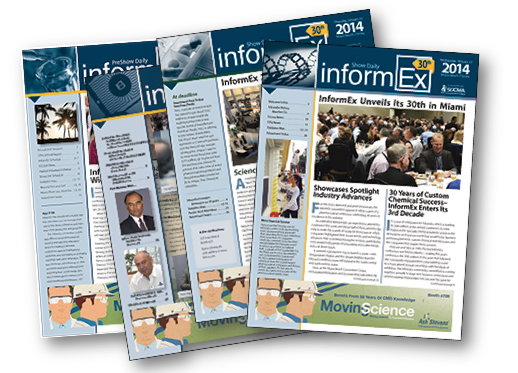When exhibiting at a science industry trade show, boring is your enemy. Your goal is to create memorable buzz — and to make it look easy. This means your booth staff is calm yet energized, marketing materials are polished and organized, and messaging is powerful and consistent. This requires smart planning. By keeping your efforts focused through an integrated marketing approach, you’ll ensure each element complements the others in support of one larger “idea” or message you want your audience to remember. Here’s a look at the essential trade show checklist that you can accomplish before you arrive at the show.
1. Prepare a booth that excites and educates.
How will you draw attendees to your booth? Games and interesting giveaways will grab attention, but consider quality of visitors over quantity. Be sure that people who stop by really learn something about your company’s offerings — give them a reason to talk to you. Make sure the science supporting your products and services is accessible to anyone; displays and demos help make technical products such as lab instrumentation easier to understand.
2. Build traffic with pre-show promotion.
Develop a segmented list of target consumers you think will be attending the show. (When in doubt, contact the show organizer for information on how to best reach attendees.) Send one or two pre-show emails to promote happenings at your booth, as well as any educational sessions or speaking events in which you’ll participate. Follow up with this list after the show to share valuable content such as your presentation or scientific posters.
3. Nail down talking points and booth “content.”
What are the top three things you want attendees to know about your company? Assemble a “pocket guide” for everyone who will be interfacing with attendees; include key message points and a schedule of company events during the show. Again, keep science accessible to all — at least on the first pass, until you know attendees want to know more. For media and potential customers stopping by your booth, gather hard copies of marketing collateral that you may want to reference on the spot.
4. Get to know (and love) the Show Daily.
Onsite conference newspapers exist because attendees actually read them. Show dailies typically include an expo map and calendar of daily events, as well as articles and advertising opportun ities that can help draw traffic to your booth or events. Contact the conference organizer up to six months before the conference to learn how you can gain visibility in the Show Daily publication. There’s often a range of options that may include electronic distribution.
ities that can help draw traffic to your booth or events. Contact the conference organizer up to six months before the conference to learn how you can gain visibility in the Show Daily publication. There’s often a range of options that may include electronic distribution.
5. Develop your social media plan.
Identify one or two people to be in charge of social media postings leading up to and during the show; identify key attendees to follow and hash tags to include in posts. Pre-write five posts per day that will draw people to your booth and website. But be timely too: Create a calendar of on-site education sessions that would interest your audience and assign someone to attend the sessions and provide quick blog posts or tweets on interesting takeaways. Also, monitor your feeds and geo-location features of your social media accounts to arrange in-person meetups. It’s not often that so many people from your circle are in the same place.
6. Explore speaking opportunities.
What unique and valuable knowledge can you offer to conference attendees? Speakers are often confirmed nine months or more in advance, so early planning is essential. Involve scientists from throughout the organization if they have interesting research or expertise to share. A press conference is another option worth exploring — and one that requires less lead-time. Leverage speaking events via social media and promote it at your booth. Likewise, encourage your audience at speaking events to come by your booth for a report, a flash drive with your presentation, or another content-rich giveaway.
7. Plan for on-site competitive analysis.
Use part of your time at the show to gather intelligence on the competition. Identify the top three competitors, and assign someone to visit each booth to stealthily gather details. If permitted at the convention hall, take pictures of displays you love with notes on unique strategies to build booth traffic. The next conference will be here before you know it, and it’s always good to have inspiring ideas to build upon.
8. Prepare for fast follow-up.
In the weeks leading up to the show, plan for how you’ll be reaching out to people you meet on the floor or at events. Develop an easy-to-use system/lead card staff can use to record on-site contacts and follow up with a personalized message within 48 hours of meeting. Write as much of the message as possible before the show to ease the busywork later.
More Tips for Your Trade Show Checklist
Get more insights and tips in our post, “Steal These Event Activation Secrets From A Tradeshow and Conference Expert.”
How do you plan for a successful trade show? Share your best tips in the Marketing Elements comments section. Or email us at cenmediagroup@acs.org.


















